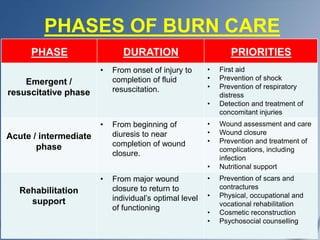Most of the deaths from burn trauma in the emergent phase that require a referral to a burn center result from:
cardiac arrest related to septic shock
Infection
adrenal failure
hypovolemic shock and renal failure.
The Correct Answer is D
A. Cardiac arrest related to septic shock:
Septic shock can occur in burn patients due to the breakdown of the skin barrier, which allows pathogens to enter the bloodstream and cause systemic infection. However, while septic shock is a serious complication of burn injuries, it is not the primary cause of death in the emergent phase. Septic shock can lead to multiple organ failure and contribute to mortality, but it is often a later complication rather than an immediate cause in the emergent phase.
B. Infection:
Infections are a significant concern in burn patients, especially as the burn wound provides an ideal environment for bacterial growth. However, infections typically contribute more significantly to mortality in the later phases of burn care rather than in the emergent phase. In the emergent phase, hypovolemic shock and other immediate complications have a greater impact on mortality.
C. Adrenal failure:
Adrenal failure, specifically acute adrenal insufficiency or Addisonian crisis, can occur in burn patients due to the stress response and corticosteroid depletion. While adrenal insufficiency is a concern in severe burn cases, it is not the primary cause of death in the emergent phase requiring referral to a burn center.
D. Hypovolemic shock and renal failure:
Hypovolemic shock is a critical concern in the emergent phase of burn trauma because burns can lead to significant fluid loss and electrolyte imbalances. Hypovolemic shock results from insufficient circulating blood volume, leading to inadequate perfusion of organs and tissues, which can be life-threatening. Additionally, renal failure can develop due to hypovolemia, decreased cardiac output, and the release of inflammatory mediators, leading to acute kidney injury (AKI). Hypovolemic shock and subsequent renal failure are major contributors to mortality in the emergent phase of burn trauma, necessitating prompt referral to a burn center for specialized care.

Nursing Test Bank
Naxlex Comprehensive Predictor Exams
Related Questions
Correct Answer is B
Explanation
A. Infection: While infection can certainly delay wound healing and contribute to the development of chronic wounds, it is more of a local factor rather than a systemic cause. Infections can hinder the normal healing process and lead to tissue damage, inflammation, and prolonged wound healing.
B. Malnutrition
A chronic wound is a wound that fails to progress through the normal stages of healing in an orderly and timely manner. Systemic factors can significantly impact wound healing, and malnutrition is one such systemic cause. Malnutrition, which refers to an inadequate intake or absorption of nutrients essential for healing, can impair the body's ability to repair tissues, fight infection, and generate new cells.
C. Continued pressure: Prolonged pressure, such as that experienced in pressure ulcers, can lead to tissue ischemia (lack of blood flow) and tissue necrosis, resulting in chronic wounds. However, this is considered a local factor related to the specific site of the wound and pressure-related damage.
D. Venous insufficiency: Venous insufficiency can cause chronic wounds, particularly venous ulcers, due to impaired venous return leading to increased pressure in the veins of the lower extremities. This pressure can result in tissue damage and poor wound healing. While venous insufficiency is a systemic condition, it primarily affects specific areas of the body (such as the lower legs) and is more directly related to the development of localized chronic wounds in those areas.
Correct Answer is ["A","D","E"]
Explanation
A. Decreased plasma volume:Burn injuries cause a significant inflammatory response, leading to fluid shifts from the intravascular space to the interstitial space. This results in hypovolemia and decreased plasma volume, especially during the acute phase of burns.
B. Diuresis:Diuresis typically occurs after fluid resuscitation and stabilization of the client (in the later phase of burn recovery). In the initial phase, oliguria is more common due to hypovolemia and reduced renal perfusion.
C. Hypermagnesemia:Hypermagnesemia is not typically associated with burn injuries. Instead, clients with burns often experience hypomagnesemia due to fluid shifts, protein loss, and increased renal losses.
D. Capillary leak:Burn injuries lead to a systemic inflammatory response, causing capillary leak syndrome. This increases vascular permeability, allowing fluid, electrolytes, and proteins to leak into the interstitial spaces, contributing to edema and hypovolemia.
E. Loss of protein:Proteins are lost through damaged capillaries and open burn wounds, contributing to decreased oncotic pressure, edema, and a need for aggressive nutritional support to promote healing and recovery.
Whether you are a student looking to ace your exams or a practicing nurse seeking to enhance your expertise , our nursing education contents will empower you with the confidence and competence to make a difference in the lives of patients and become a respected leader in the healthcare field.
Visit Naxlex, invest in your future and unlock endless possibilities with our unparalleled nursing education contents today
Report Wrong Answer on the Current Question
Do you disagree with the answer? If yes, what is your expected answer? Explain.
Kindly be descriptive with the issue you are facing.
